MyPortugalHoliday.com
The best independent guide to Madeira
MyPortugalHoliday.com
The best independent guide to Madeira
Madeira Travel Guide 2025: Everything You Need to Know Before You Visit
Madeira is an oasis of green within the Atlantic Ocean. This lush island, with its permanent spring-like climate, is diverse and fascinating, and one of the truly unique holiday destinations of Europe.
Found within the island are dramatic natural scenery, towering mountains and tropical forests, and people who are welcoming and hospitable, reflecting the laid-back nature of the Portuguese.
Madeira is not your typical beach holiday destination. It's a place to go out and explore, immerse yourself in local culture, or find solitude while hiking one of the magnificent trails that crisscross the island.
If you are seeking a relaxing holiday, Madeira boasts world-class hotels, a glorious climate and a social atmosphere while offering exceptional value for money.
Madeira is diverse and thrilling, offering a holiday that can be as exciting or relaxing as you desire. This article will provide an introduction to Madeira by answering some common holiday questions.
What are the Highlights of Madeira?
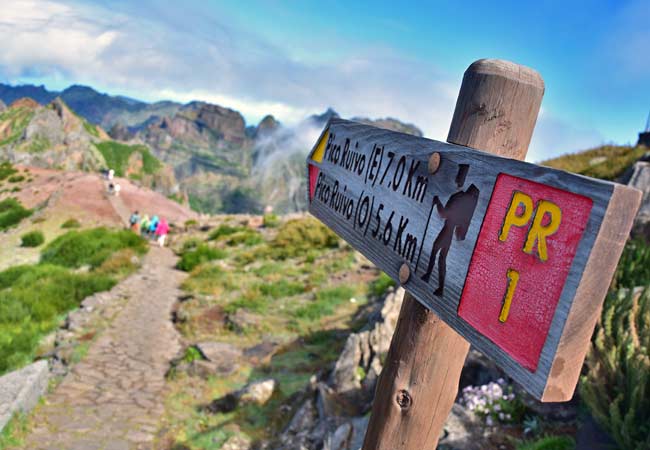
Hiking above the cloud line between Pico do Arieiro and Pico Ruivo offers one of Europe's most spectacular mountain walks. This ridge trail connects Madeira's third and highest peaks, where you'll walk through otherworldly landscapes above a sea of clouds with views extending across the entire island.

Funchal's rich history and culture come alive as you wander its cobbled streets and colonial buildings, but the real adventure begins with the cable car journey to Monte. From this elevated parish, the traditional wicker toboggan ride back down the steep streets is an exhilarating experience that dates back to the 1850s, when it was introduced as a fast means of downhill transport.
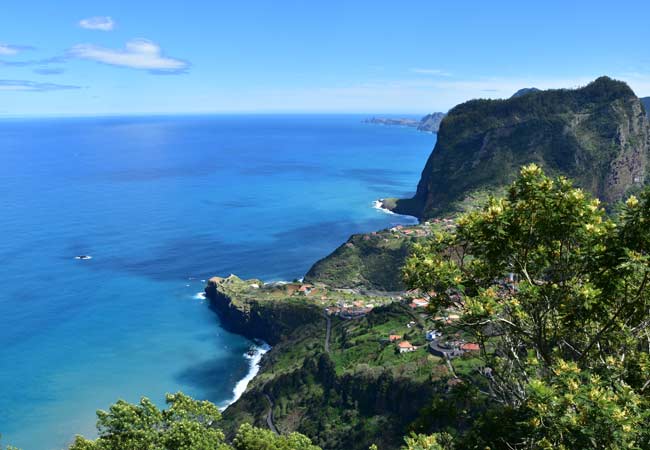
The northern coastline of Madeira presents nature at its most dramatic, with towering cliffs, pristine waterfalls cascading directly into the ocean, and rugged headlands battered by Atlantic waves. This untamed shoreline offers some of the island's most breathtaking views and scenic drives.
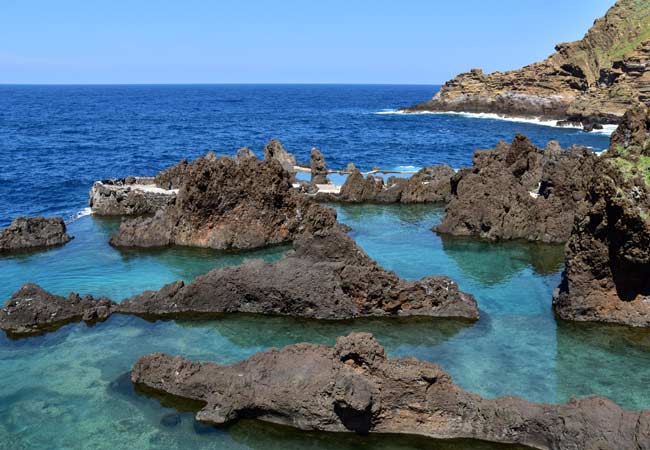
At Porto Moniz, natural volcanic rock pools offer a unique swimming experience. These protected pools, refreshed by each incoming tide, allow you to safely enjoy the ocean while watching powerful waves crash against the outer rocks - creating an unforgettable blend of relaxation and natural spectacle.
Related articles: Funchal guide - Porto Moniz - Pico do Arieiro
Madeira Introduction
Madeira, along with its sister island Porto Santo and the uninhabited Desertas and Selvagens islands, forms an autonomous region of Portugal. The archipelago's volcanic origins have blessed it with dramatic landscapes, from the soaring central mountain range to the plunging coastal cliffs. Despite its proximity to Africa at 32°N latitude, Madeira enjoys a remarkably mild climate with average temperatures ranging from 16°C in winter to 23°C in summer.
The island lies closer to mainland Africa (800 km) than to Lisbon (1,200 km), while the Canary Islands are 400 km to the south. The southern latitude of Madeira and close proximity to the Canaries would suggest an island of soaring heat and parched lands, but this is not true.

The green and mountainous interior of Madeira
The Atlantic Ocean tempers any temperature extremes, while the mountains and moisture-laden winds ensure rain falls and keeps the island lush and green. Madeira is often referred to as the 'island of eternal spring', and this description is truly fitting. The combination of altitude and Atlantic influences creates distinct microclimates across the island, allowing both tropical and Mediterranean species to thrive.
The southern coast features banana plantations and vineyards on terraced hillsides, while the northern coast offers dramatic seascapes with waves crashing against volcanic cliffs. The central mountain range, with its jagged peaks often rising above the clouds, creates one of Europe's most stunning natural environments.
This geographical diversity has shaped not only the island's ecology but also its culture and way of life. The mountainous terrain led to the development of the remarkable levada system - a network of water channels that has served the island since the 16th century and now provides some of Europe's most unique hiking trails.
Related articles: Top 10 of Madeira - 1 week in Madeira - When to visit Madeira?
Who Should Visit Madeira?
Madeira appeals to diverse travellers seeking more than a typical Mediterranean beach holiday. The island particularly attracts nature enthusiasts, drawn to its 2,000 km network of levada walking trails, where lush landscapes and dramatic mountain vistas create unforgettable hiking experiences. Adventure seekers will find excellent opportunities for hiking, mountain biking, canyoning, and paragliding throughout the year.
The island is also perfect for those interested in wellness and relaxation, offering world-class spa hotels, year-round gentle climate, and peaceful botanical gardens. The slow pace of life, combined with high-quality hotels and restaurants, makes it ideal for visitors wanting to escape the bustle of everyday life.
While Madeira has traditionally attracted a more mature visitor due to its safe environment, high-quality facilities and excellent value for money, it's increasingly drawing younger independent travellers. These visitors appreciate the blend of outdoor activities, vibrant cultural scene in Funchal, and authentic local experiences, from village festivals to farmers' markets.
The only consideration is the lack of sandy beaches, but this is easily solved by combining your stay with time on Porto Santo, Madeira's sister island. Porto Santo boasts a stunning 9-km golden beach along its southern coast and remains one of Europe's least discovered beach destinations.
Our opinion: Madeira's combination of natural beauty, activities, culture, and cuisine makes it ideal for active travellers of all ages who want to explore beyond the typical tourist trail.
Related articles: Top 10 activities in Madeira - Day trip to Porto Santo
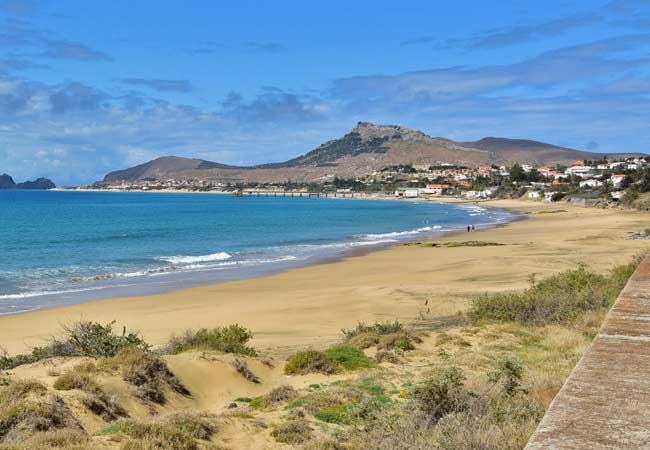
Porto Santo is much more arid than Madeira, but there is a beautiful 7km beach
Where to go in Madeira?
Most visitors to Madeira are based close to Funchal, the largest city on the island and where over half of the island's population lives.
Funchal is a pretty and welcoming city that is a charming mix of classic Portuguese architecture, whitewashed houses and carefully maintained gardens. The main hotel zone is to the west of Funchal, and if you book a package holiday, you will most likely be based within this area.
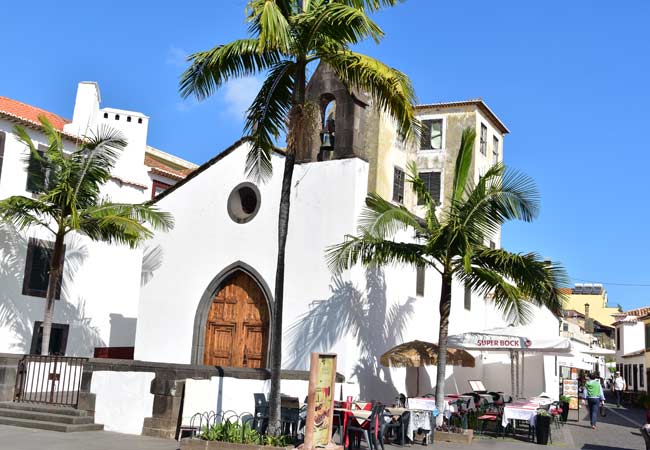
The historic centre of Funchal is an enjoyable locaction for a holiday
The interior of Madeira is formed of massive extinct volcanoes and deep river valleys that have been carved out by constant mountain rains. Pico Ruivo is the highest point of Madeira at 1,850 m, while the third highest peak, Pico do Arieiro, is easily accessible by road.
The deep valleys provided protection and safety to the early population of Madeira during numerous pirate raids. The most famous of these valleys is the Curral das Freiras (Nuns' Refuge), which is surrounded by towering cliffs on three sides.
Crossing the island are a series of complex waterways that diverted water from the wet northern side to the fertile lands on the eastern side of Madeira. Today these small streams and associated footpaths provide visitors with wonderful hiking routes (known as levadas), which pass through some of the most spectacular landscapes in Madeira.
The coastline of Madeira is a jagged mixture of massive cliffs and stony beaches. The cliffs outside the town of Câmara de Lobos are some of the highest in Europe, and there is a fear-inducing skywalk which protrudes out over the 500 m drop.
The remote town of Porto Moniz on the very northwestern edge is famed for its lava pools that are filled by the high tide.
Related articles: Cabo Girão Skywalk
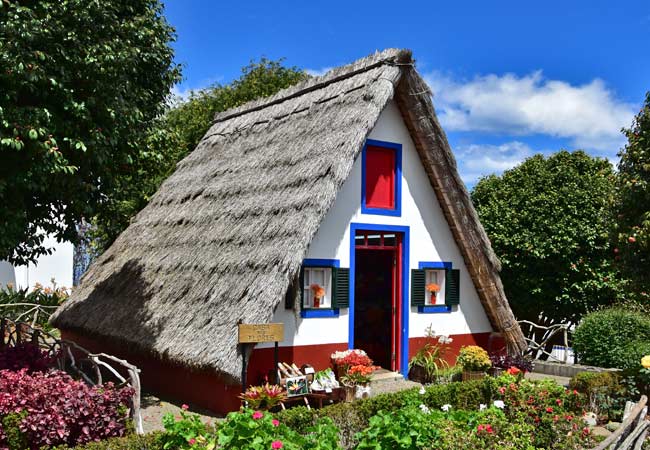
The traditional houses of Madeira in Santana
When to visit Madeira?
There are two peak seasons for Madeira: the Christmas holidays and school summer holidays (July-August). If you are planning a holiday during these periods, always book flights and accommodation well in advance, as flights will be expensive, and hotels do sell out.
Early spring and autumn are the best times of the year to visit as the weather is still wonderful but there are not the summertime crowds or cruise ships. The winter months experience the most rain, but this tends to fall on the northern side of the island, whereas Funchal to the south is much drier.
Insight: The main festival of Madeira is the flower festival hosted in Funchal between the 23rd of April and the 24th of May.
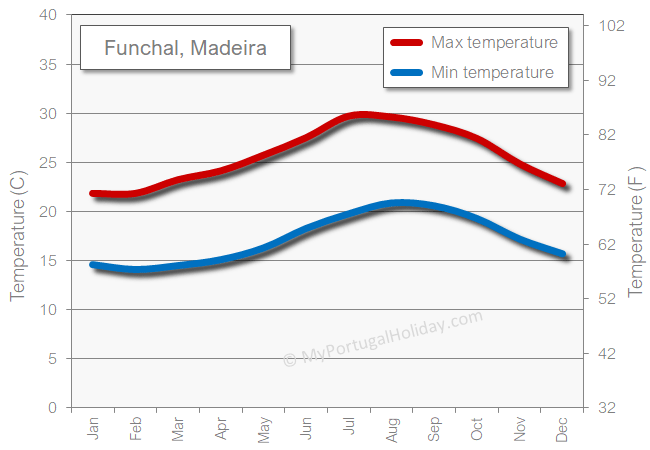
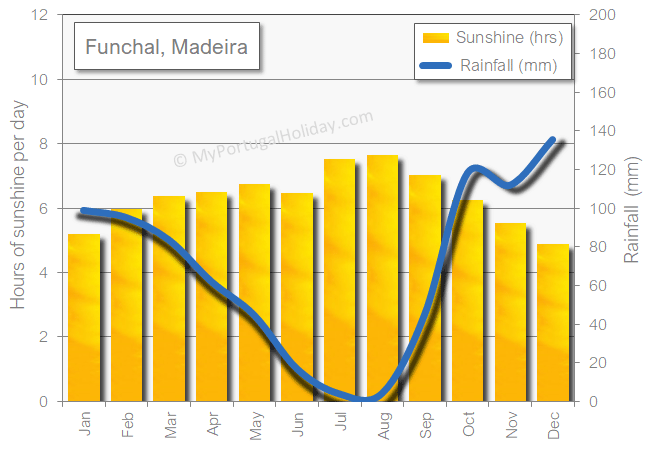
June is a unique month in Madeira, as the island is often covered in cloud (but rarely rains) and is frequently referred to as "June gloom" by locals. By July, the intense summer sun burns this cloud away in the early morning.
Our advice: If you are holidaying in June, head to Lisbon or Porto for their Popular Saints Festivals and guaranteed great weather.
Related articles: Our Lisbon guide – Porto guide
Suggested Itineraries for a Holiday to Madeira?
A typical holiday to Madeira is based in or near Funchal (many of the major hotels are to the west of the city), and the island is explored via organised day trips or with a rental car.
If you wish to explore Madeira independently, a recommended itinerary with a rental car is; Day 1) Funchal and Monte Day 2) Câmara De Lobos and the Cabo Girão Cliffs Day 3) Porto Moniz Day 4) the mountains of Pico do Arieiro and Pico Ruivo Day 5) Ribeiro Frio, Santana and Machico Day 6) Curral Das Freiras and Day 7) São Vicente and caves.
A map of this suggested itinerary is shown below.
Guided tours are a hassle-free way to explore Madeira and also provide a chance to meet fellow tourists. There are many different tour companies providing guided tours of Madeira, but they all tend to split the island into two: east and west. The western tours typically visit Câmara de Lobos, São Vicente and Porto Moniz, while the eastern tours include Santana, Ribeiro Frio and Machico.
Related articles: 1 week in Madeira
What about the beaches?
The powerful waves and strong sea currents have prevented Madeira's coastline from retaining any substantial sandy beaches.
This has actually been a blessing for the island. The lack of sandy beaches has prevented Madeira from being overrun by package holidays and mega hotel developments, as with the culturally devoid Canary Islands.
Madeira has two artificial sandy beaches, located in Calheta and Machico. Both are protected from the ocean currents and winter storms by sea walls, but this means neither beach is very large.
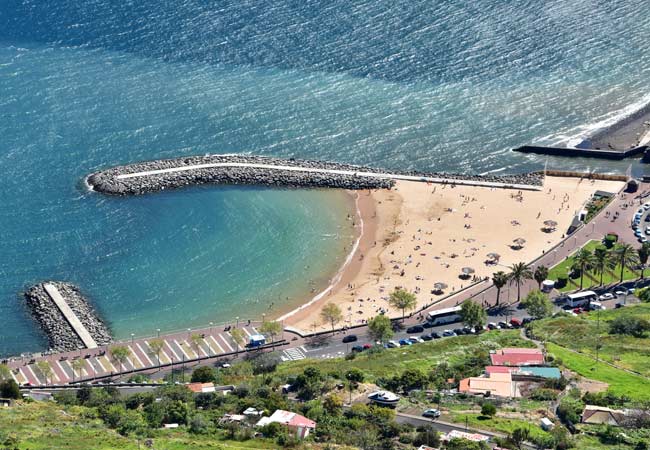
The Paira do Machico beach is to the northeast of Madeira
If you truly want a beach destination, consider visiting Porto Santo for a portion of your holiday to Madeira. There is a regular ferry connecting Funchal to Porto Santo, and the island has its own airport with a few services to Europe.
Another option is to book a hotel with a beautiful swimming pool complex and grounds, which can be equally pleasant for a relaxing holiday.
Our opinion: Madeira may not have the bountiful beaches of other islands in the eastern Atlantic Ocean, but it easily compensates with mountainous scenery, rugged coastlines, and culturally rich towns and villages.
Related articles: The best sandy beaches of Madeira
The Levadas of Madeira
One of Madeira's most remarkable features is its network of levadas, ingenious irrigation channels that have carried water from the rainy north to the drier south since the 16th century. These narrow waterways and their maintenance paths now form over 2,000 km of walking trails, offering some of Europe's most unique and beautiful hikes.
The Levada do Caldeirão Verde provides one of the island's most rewarding walks. This 6.5 km trail winds through UNESCO-protected laurel forest before reaching a spectacular 100-metre waterfall hidden in a natural amphitheatre. The path occasionally tunnels through the mountainside, adding to the sense of adventure.
For waterfall enthusiasts, the Levada das 25 Fontes (25 Springs) is unmissable. This popular route leads to a wall of cascading springs and can be combined with the nearby Levada do Risco for a full day's walking. Both trails offer stunning views across Madeira's central mountains and verdant valleys.
These historic waterways range from gentle paths suitable for casual strolls to more challenging routes requiring a head for heights. While many levadas are easily accessible, some traverse remote terrain or narrow ledges. We strongly recommend checking current weather conditions, wearing proper walking shoes, and carrying a torch for tunnels.
Traditional Madeiran Cuisine
Madeira's cuisine reflects its maritime location and mountainous terrain, creating a unique blend of land and sea flavours that have evolved over centuries. The island's traditional dishes showcase fresh local ingredients and time-honoured cooking methods.
Seafood features prominently, with black scabbard fish (espada) being a local delicacy, often served with fried banana or passion fruit sauce. The coastal waters provide excellent limpets (lapas), grilled and served with garlic butter and lemon. From the mountains comes espetada, tender beef rubbed with garlic and salt, skewered on bay laurel sticks and grilled over hot coals, traditionally served with bolo do caco, a garlic-buttered flatbread made with sweet potato.
The island's subtropical climate nurtures unique fruits, including the sweet Madeira banana and passion fruit, which feature in both desserts and drinks. The famous bolo de mel, a dark spicy honey cake reflecting the island's sugar trade history, is traditionally broken by hand rather than cut.
The local drink, poncha, made with aguardente de cana (sugar cane rum), honey, and fresh fruit juice, perfectly captures the island's spirit.
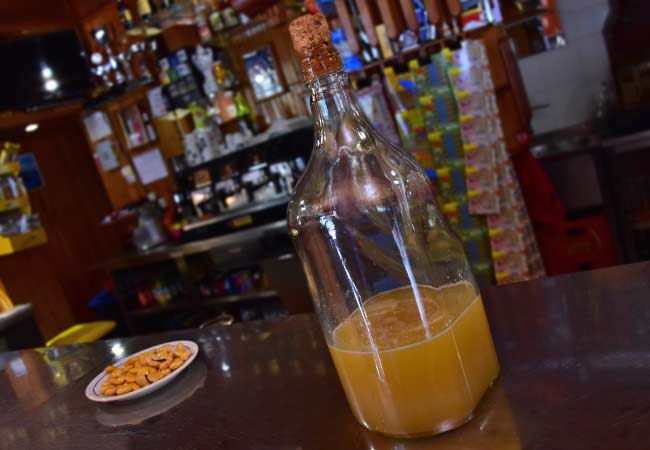
A bottle of Poncha ready to make the bar jolly…
Is Language Going to Be a Problem?
All people who work within the tourism industry speak English fluently and often a third European language. All restaurant menus have an English section, while all transportation uses English as the second language. The Portuguese always appreciate an effort to speak their language.
Madeira for children?
Madeira is not a conventional or well-known destination for a family holiday but is ideal for children. The Portuguese are very welcoming and supportive of families, especially if travelling with young children. The island is very safe, all tourist facilities and hotels are of a very high standard, and shops sell all common branded goods.
As for activities, there is the cable car and toboggan run in Funchal, boat tours and the lava pools in Porto Moniz. The beaches in Madeira tend to be stony and the sea waters are cold.
Travel to Madeira and Madeira airport
Madeira is served by a modern international airport situated on the northeastern side of the island.
There are numerous routes connecting Madeira to major European cities, and many of these flights are operated by low-cost airlines, so there can be bargains to be found if booked far enough in advance.
Onward travel from the airport is very easy, as there is a regular bus service, called the Aerobus, which connects the airport to Funchal (40 minutes, €5.00). For faster transfers, there are taxis or pre-booked transfers.
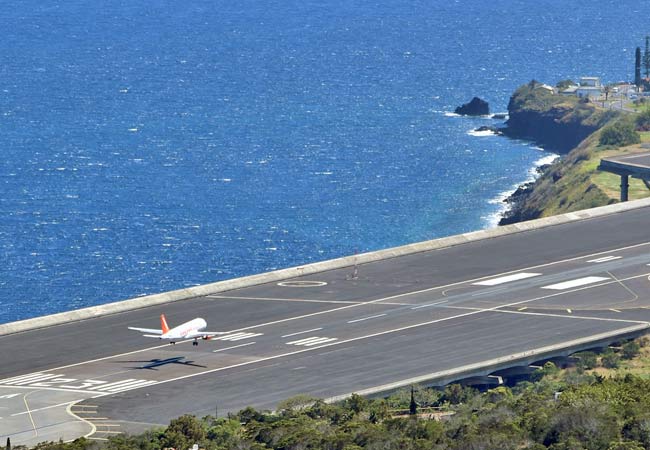
The run way of Madeira spans a deep valley and extends out over the sea… The approach to Madeira is one of the most stunning in Europe
Insight: Madeira airport used to have the reputation as one of the world's most dangerous airports before the large and modern airport was constructed in 2002. Do not listen to scare stories; the airport is perfectly safe, but pilots do need additional training due to the crosswinds and zigzag approach.

















